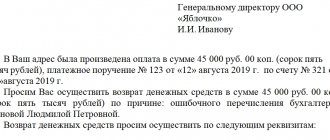Types of special bank accounts
A special account is a separate bank account in which money that is not accountable through a checking account is stored and spent. A special account is designed to separate a company's specific cash flow from the general one for the purpose of:
- spend these funds to solve specific problems, for example, a clearing account;
- separate out amounts that should not belong to the account owner, for example, a debtor's account.
Most often, the source of income for special accounts is payments from individuals or legal entities for services provided to them. The functionality of a special account is the same as that of a current bank account, but all actions with it are subject to certain rules depending on the type of account.
There are many special accounts, and their list is constantly growing. In addition to the 12 accounts listed in the Central Bank Instructions, special accounts also include those specified in various laws, for example, a special account for bankruptcy proceedings.
Select a bank for a special account
Special paying agent account: opening procedure
Legal entities and individual entrepreneurs are required to open this type of account, both those accepting payments in favor of third parties - suppliers, and the suppliers themselves. According to the current procedure for opening accounts in credit institutions, special accounts have a separate designation: 40821 - “Special bank account of the paying agent, bank paying agent (subagent), supplier,” which allows them to be identified when used in settlements (clause 4.43 of the “Regulations on the Chart of Accounts” accounting for credit institutions", approved by the Central Bank of the Russian Federation on February 27, 2017 No. 579-P).
This type of account can be opened in any bank, but in most cases there is a requirement that it is opened only in the credit institution where the agent or supplier has a valid current account.
To open an account with the bank, you must provide an application in the prescribed form and attach to it a copy of the agency agreement with the supplier or other paying agent, as well as a standard package of documents that is used to open a simple current account. After checking the submitted documents, the account will be opened - on average it takes 2-3 days.
The agreement on a special account provides for the obligation of the agent to promptly inform the bank about the termination of the agreement with the supplier, or about the conclusion of new agreements both with previous counterparties for accepting payments and with new ones. In addition, the agent is obliged to notify the credit institution of the termination of activities for accepting payments in favor of third parties.
Accounts for bank payment agents are opened in a similar manner with the only difference being that instead of an agency agreement with a supplier, it is necessary to submit an agency agreement with a money transfer operator or another bank payment agent.
Note that in most Russian banks, opening an account for 40821 paying agents involves high tariffs. Credit institutions explain this by the fact that the activities of payment acceptance agents carry many risks for the bank and high tariffs partially protect them from possible fraudulent schemes.
Read also: Payment agents and online cash registers
Bank payment agent or subagent account
You must open this special account if you take on part of the banking functions, for example, loan payments. Namely, on behalf of the bank you accept payments from individuals. persons (including using self-service devices), give them cash or provide electronic means of payment.
Available operations on this account:
- crediting cash received from individuals. persons;
- accepting non-cash transfers from special accounts of operators;
- transfers to recipient accounts.
You can open several such special accounts in any banks.
How to open - features of the procedure
Generally speaking, the procedure for opening a special account is almost no different from how to open a regular account.
You are required to write an application and prepare documentation. The following documents are required:
- A copy of the paper that confirms the status of the paying agent. This may be a copy of the agreement on accepting payments from individuals
. - A photocopy of the certificate of state registration of a legal entity.
- A photocopy of the certificate of registration with the Federal Tax Service.
- A copy of an extract from the Unified State Register of Legal Entities (USRLE).
- Agreement on the creation of a special account (this is handled by the bank).
- A photocopy of the decision to create a legal entity. It must be certified by the signature of the manager and the seal
officially used in the company. - Questionnaires of a client of a financial institution and other individuals who have the right to manipulate a special account (including using web banking).
- Notarized photocopies of the passports
of the citizens mentioned in the seventh paragraph. They are attached to the questionnaires. - An order on the management of accounting records and the provision of payment documents to the banking organization - with one signature (if the company’s staff does not provide for the presence of a chief accountant).
The contents of the list may vary. It is better to clarify the question with a specialist at a specific bank. A lot depends on:
- company format (legal entity or individual entrepreneur);
- “resident” and “non-resident” statuses.
Note 3.
Who should open? 40821 can be opened by a paying agent, subagent, or supplier. Each of these participants requires its own documentation.
Paying agent account
Designed to record payments from individuals. persons for the services they received, for example, payments for housing and communal services. This special account includes:
- cash deposit;
- accepting transfers from agent special accounts;
- transfers to special accounts of other agents/service providers.
We recommend: Banks with the cheapest opening and maintenance of a current account for individual entrepreneurs and LLCs.
Clearing bank account
It meets the same goals as the previous special account, but here the owner is already a clearing organization. It acts as a controlling element in clearing transactions and is obliged to open accounts for the placement of assets of clearing participants, central counterparties and other persons.
As a general rule, the clearing company does not have the right to transfer its own money to this account. Since the amount in the account does not belong to its owner, clearing accounts are prohibited from seizing or restricting transactions on them.
Merchant bank account
Trading accounts are issued by clearing participants. It can be opened in rubles, foreign currency, or precious metals. This account contains money and precious metals for:
- Fulfillment or security of obligations under a transaction.
- Payment of remuneration to the clearing organization.
Operations on the account are carried out on the basis of orders of clearing organizations. When opening this type of account, you must specify a clearing organization that will manage the assets.
Payment system guarantee fund account
Banks working with payment systems, for example, MIR, must form a special fund from personal contributions to a separate account (to cover possible risks). For this purpose, the payment system operator opens a payment system guarantee fund account. He also sets the size of the transfers. If the bank stops working with the payment system, its payment is returned.
Such special accounts can only be located in banks or non-banking organizations that do not have the right to place raised money to generate income, for example, in the Central Bank. Accounts are not subject to seizures, restrictions or penalties due to debts of the operator or system participants.
We recommend: Rating of banks by cash settlement services for individual entrepreneurs and legal entities with customer reviews.
Escrow account
To insure against the risk of non-payment when concluding an agreement for the supply of products/provision of services, you can use an escrow account. The work flow is as follows:
- The buyer opens a special account and deposits the agreement amount into it.
- The bank is blocking the money.
- The seller fully fulfills its obligations.
- The money is transferred in his favor.
If the terms of the transaction are violated, the money is transferred back to the buyer. Unless otherwise agreed, neither party can dispose of the account.
Providing bids at auction step by step
The Government of the Russian Federation has approved a list of trading platforms on which state and municipal authorities are allowed to make purchases. To date, all of them have concluded agreements with banking structures that outline cooperation schemes and basic procedures. In particular, the process for submitting application security is as follows:
- The participant gets acquainted with the documentation and deposits into his account the amount specified in the contract. After this, he can submit a request to participate in the auction.
- As soon as the deadline for collecting applications comes to an end, the operator sends information to banking institutions about bidders and the amounts that need to be blocked in special-purpose accounts.
- After receiving data from the ETP operator, the bank needs about an hour to complete actions to block funds. If there is not enough money in a participant’s account, the bank informs the trading platform about this, and it cancels the application for participation.
- The money remains blocked until the winning bidder is determined. Before this time, funds are unfrozen if the application was rejected or the auction did not take place for one reason or another. The defrosting time is 1 hour.
- If the account owner is the winner, then an amount equal to the ETP remuneration for the provision of services will be additionally deducted from his special account. According to the law, the upper limit of this amount is 1% of the NMCC (up to 5,000 rubles).
Experts advise carefully monitoring the status of your account, since insufficient funds and rejection of the application for this reason will not allow you to send the offer again.
Collateral account
This special account is also opened to protect the owner from the risk of not receiving money. The company's funds are deposited into it in the amount of the pledge (by agreement with another company or bank), and profits from the pledged property, insurance payments and other types of income are also transferred. The pledgor has free use of the account, but work with it may be limited if the result is that the balance becomes less than the secured obligations.
You, as a supplier of goods/services, can open such an account together with the client company if it is in dire financial straits. Money in a collateral account is protected from seizures and seizures by government agencies.
Additional features
Payment Analysis
Thanks to the information contained in the document Invoice from supplier , the accountant will automatically generate a report for the manager, located in the section For the manager – Accounts payable:
- report Invoices not paid to suppliers .
Unpaid invoices can also be monitored in the document journal Invoices from suppliers using the Due Date and Payment .
An overdue Payment Date is highlighted in red. Also, the payment status in the Payment if the goods and materials (works, services) on the invoice from the supplier have been received and not paid or partially paid.
If the invoice is paid, but it is not indicated in the payment document ( Payment status is not automatically changed), change it manually in the Invoices from suppliers using the Change status or directly in the document itself in the Payment status .
BukhExpert8 advises filling out the Invoice for payment in payment documents so that the Payment Status of the Invoice from Supplier document changes automatically.
Depending on the payment, you can also configure conditional formatting of the list.
Receipt analysis
In the document journal Invoices from suppliers, the Receipt column controls the receipt of inventory items (works, services) on the invoice.
The receipt status is displayed only in the Invoices from Suppliers Invoice from Supplier document, the Receipt Status even by clicking the More .
Receipt column is highlighted in red if the invoice has been paid, but inventory items (works, services) have not been shipped or have been partially shipped.
For accounts for which goods and materials, works (services) were received, but not indicated in the receipt documents, change the Receipt Status manually in the Invoices from Suppliers using the Change Status .
If an Invoice from the supplier was issued upon receipt of fixed assets, and the receipt was documented using the document Receipt (act, invoice) type of operation Fixed Assets , then the Receipt Status is also changed only manually, since the program does not automatically track the delivery of fixed assets according to the document Receipt (act, invoice) type of operation Basic facilities .
BukhExpert8 advises filling out the Invoice for payment in the delivery documents so that the Receipt Status of document from the supplier changes automatically.
Depending on the Receipt, you can also configure the conditional formatting of the list.
Test yourself! Take a test on this topic using the link >>
Did the article help?
Get another secret bonus and full access to the BukhExpert8 help system for 14 days free of charge





